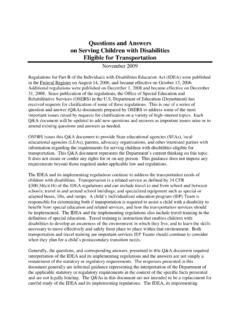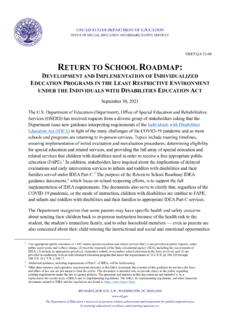Transcription of PART C OF THE INDIVIDUALS WITH DISABILITIES …
1 part C OF THEINDIVIDUALS WITH DISABILITIESEDUCATION ACTFINAL REGULATIONSNONREGUL ATORY GUIDANCENOVEMBER 2011 Table of Contents Page A 1: CHANGES IN EARLY INTERVENTION: A SUMMARY OF MAJOR REGULATORY CHANGES FOR PARENTS, EARLY INTERVENTION SERVICE PROVIDERS, AND STATE LEAD AGENCIES A 3: Family Engagement A 3: Child Find/Evaluations and Assessments/Eligibility/Initial IFSP A 6: IFSP Development, Implementation, and Review A 7: Transition (including part C to part B)/Exiting part C A 10: Coordination with Head Start/Early Head Start, Early Education, and Child Care B 1: USE OF PUBLIC BENEFITS OR INSURANCE OR PRIVATE INSURANCE TO PAY FOR part C SERVICES B 3: Federal Requirements for States to Coordinate Resources for part C Services, Use part C Funds as a Payor of Last Resort, and Ensure Methods to Ensure the Provision of, and Financial Responsibility for, part C Services B 4: Federal Requirements for a State s System of Payments B 7: Treatment of Funds Received under Public Benefits or Insurance, Private Insurance, or Family Fees C 1: CHANGES IN EARLY INTERVENTION: A SUMMARY OF MAJOR REGULATORY CHANGES RELATED TO THE ADMINISTRATIVE RESPONSIBILITES OF STATE LEAD AGENCIES C 3: State Application and Assurances C 9: Federal and State Monitoring and Enforcement C 11: State Interagency Coordinating Council C 12.
2 Procedural Safeguards A - 1 IDEA part C FINAL REGULATIONS ISSUED SEPTEMBER 28, 2011 AND EFFECTIVE OCTOBER 28, 2011 CHANGES IN EARLY INTERVENTION: A SUMMARY OF MAJOR REGULATORY CHANGES FOR PARENTS, EARLY INTERVENTION SERVICE PROVIDERS, AND STATE LEAD AGENCIES NON-REGULATORY GUIDANCE November 2011 Office of Special Education Programs Office of Special Education and Rehabilitative Services Department of Education A - 2 PURPOSE OF THIS GUIDANCE This guidance provides parents, early intervention service (EIS) providers, State lead agencies, and other interested parties with detailed information about the some of the changes made to the INDIVIDUALS with DISABILITIES Education Act (IDEA or Act) part C R egulations in 34 CFR part 303, as those regulations were published in the Federal Register on September 28, 2011 and made effective on October 28, 2011 (Final Regulations)
3 The Final Regulations can be found at The Final Regulations reflect changes made to the IDEA, as amended by the INDIVIDUALS with DISABILITIES Education Improvement Act of 2004, and make other necessary changes needed to implement the Early Intervention Program for Infants and Toddlers with DISABILITIES . This non-regulatory guidance focuses on the following topics where changes were made to regulatory requirements that directly affect infants and toddlers with DISABILITIES and their families and local EIS providers and programs: (1) Family Engagement; (2) Child Find/Evaluations/Assessments/Eligibility /Initial IFSP (Individualized Family Service Plan); ( 3) IFSP Development, Implementation, and Review; (4) Transition (including part C to part B)/Exiting part C; and (5) Coordination with Head Start/Early Head Start, Early Education, and Child Care programs.
4 This non-regulatory guidance identifies some of the changes made to the Final Regulations in these areas and does not impose additional requirements beyond those required under the IDEA and the Final Regulations. The IDEA, its implementing regulations, and other important documents related to the IDEA and the regulations can be found at A - 3 I. Family Engagement The Final Regulations acknowledge the importance of parents and other family members in supporting a child s development. This section identifies the changes made to 34 CFR part 303 by the Final Regulations as they directly affect the involvement of parents and families of infants and toddlers with DISABILITIES . Section (d)(1)(ii) requires that the family of a toddler with a disability who is served under part C be included in the development of the transition plan required under (d)(1)(ii) and (h).
5 (See Section IV related to Transition.) Section clarifies that if the lead agency determines, after conducting an evaluation, that a child is not an infant or toddler with a disability, the lead agency must provide the parent with prior written notice, including information about the parent s right to dispute the eligibility determination through the IDEA part C dispute resolution mechanisms. Section (d) requires the lead agency to provide parents with an initial notice when a child is referred to part C that informs parents about their rights under the IDEA part C confidentiality provisions and a summary of the record maintenance, destruction, retention, and storage policies with which participating agencies1 must comply. Section (a) requires a participating agency to comply with a parent s request to inspect and review the early intervention records of his/her child in no more than 10 days after the parent makes the request.
6 Section (c) requires a participating agency to provide, at no cost to the parent, a copy of each evaluation, assessment of the child, family assessment, and IFSP as soon as possible after each IFSP meeting. Section states the general rule that parental consent is required before a participating agency may disclose personally identifiable information under the IDEA part C regulations and identifies (rather than incorporating by reference) the IDEA-specific and FERPA-related exceptions to this rule. II. Child Find/Evaluations and Assessments/Eligibility/Initial IFSP 1 Participating agency means any individual, agency, entity, or institution that collects, maintains, or uses personally identifiable information to implement the requirements in part C of the Act and the part C regulations with respect to a particular child.
7 A participating agency includes the lead agency and EIS providers, but does not include primary referral sources, or those public agencies or private entities that act solely as funding sources for part C services. A - 4 Section identifies the major components of the statewide comprehensive, coordinated, multidisciplinary interagency system by specifically distinguishing between pre-referral activities (public awareness and child find), referral, and post-referral IFSP activities (including screening; evaluations; assessments; and IFSP development, review, and implementation). This section identifies the changes made to 34 CFR part 303 by the Final Regulations as they directly affect these major component areas. Child Find Section clarifies that the central directory of early intervention services in the State must be accessible to the general public ( , through the lead agency s Web site and other appropriate means) and include accurate, up-to-date information about early intervention services, professional and other groups that provide services to infants and toddlers with DISABILITIES , and research and demonstration projects being conducted in the State relating to infants and toddlers with DISABILITIES .
8 Section (c) requires each lead agency to inform parents of toddlers served under part C about preschool programs under section 619 of the Act as part of the transition requirements when a child exits the part C program; that information must be provided not fewer than 90 days prior to the toddler s third birthday. Section (c) requires the State to ensure that the child find system is coordinated with specific agencies, including the following State agencies (in addition to those long-referenced in 34 CFR part 303): the State agency responsible for administering the Child Abuse Prevention and Treatment Act (CAPTA), the State Early Hearing Detection and Intervention (EHDI) system, the Home Visiting program under Maternal and Child Health (MCH-Title V), Child Care programs, and the Children s Health Insurance Program (CHIP).
9 Section (a)(2)(i) requires primary referral sources to refer a child to the part C program as soon as possible but in no case more than seven days after identification. Section requires that, within 45 days after the lead agency or EIS provider receives a referral of a child, the screening (if applicable), initial evaluation, initial assessments (of the child and family), and the initial IFSP meeting for that child must be completed (45-day timeline). Screening Section adds new screening procedures and confirms that such screening procedures are not required under the Act; rather, using screening procedures i s an option that a State may choose to include as a part of its comprehensive child find system. A - 5 Under (a)(1)(i), the State must provide the parent with prior written notice of its intent to screen the child to determine whether the child is suspected of having a disability and obtain parental consent before administering the screening.
10 That notice must explain the parent s right to request an evaluation at any time during the screening process. Section (a)(1) requires the State to obtain parental consent prior to administering any screening procedures that the State elects to adopt under IDEA part C. Section (a)(2) requires the State to provide notice of the screening results to the parent and, if the screening results indicate that the child is suspected of having a disability, the State must conduct an evaluation after obtaining parental consent. Evaluations and Assessments Section (b)(2) adds an exception to the 45-day timeline. If a parent has not provided consent to the initial screening, evaluation, or assessment of a child, despite documented, repeated attempts to obtain parental consent, the lead agency must complete the initial evaluation, assessments, and IFSP meeting as soon as possible after parental consent is obtained.










